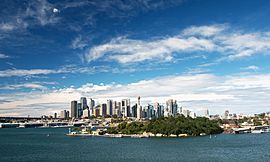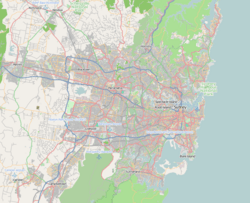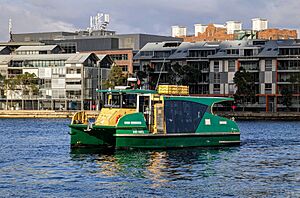Goat Island (Port Jackson) facts for kids
|
Native name:
Memel; Me-Mel
|
|
|---|---|

Goat Island, viewed from Balls Head
|
|
| Geography | |
| Location | Port Jackson |
| Coordinates | 33°51′08″S 151°11′48″E / 33.8521°S 151.1966°E |
| Area | 5.4 ha (13 acres) |
| Length | 180 m (590 ft) |
| Width | 300 m (1,000 ft) |
| Administration | |
|
Australia
|
|
| Demographics | |
| Population | 5 |
| Goat Island | |
|---|---|
| Location | Port Jackson, Sydney, New South Wales, Australia |
| Built | 1826–1994 |
| Architect | Edmund Blacket; Alexander Dawson (Colonial Magazine) |
| Owner | NSW Office of Environment and Heritage |
| Official name: Goat Island; Me-Mel (the eye) | |
| Type | State heritage (landscape) |
| Designated | 2 April 1999 |
| Reference no. | 989 |
| Type | Other - Landscape - Cultural |
| Category | Landscape - Cultural |

Goat Island (also known as Memel or Me-Mel in the Dharug language) is a special island in Port Jackson, Sydney, Australia. It's a heritage-listed spot, meaning it's important to history. The island is about 300 meters wide and 180 meters long. It covers an area of 5.4 hectares (about 13 acres).
Goat Island is located northwest of the Sydney central business district. It sits near the suburbs of Balmain and Millers Point. The island is where Darling Harbour meets the main part of Sydney Harbour.
Over the years, Goat Island has had many different jobs. It was once a place to store gunpowder and weapons. It also served as a shipyard, a police station, and even a fire station. Today, it's part of the Sydney Harbour National Park. The buildings on the island were designed by famous architects like Edmund Blacket. The NSW Office of Environment and Heritage owns the island. It was added to the New South Wales State Heritage Register in 1999.
Contents
Discovering Goat Island's Past
Indigenous History: Me-Mel, The Eye
For thousands of years, Goat Island was known as Memel or Me-Mel to the Eora people. In their language, this means "the eye." The Eora are the original Indigenous people of Port Jackson.
Captain David Collins wrote that Bennelong, an important Eora elder, considered the island his property. Bennelong was often seen there with his wife, Barangaroo. The island was a significant place for Indigenous people. It was easy to reach from the mainland by canoe. It is also believed to be Bennelong's birthplace.
Colonial History: Early European Uses
When Europeans first arrived, some maps mixed up Goat Island with Cockatoo Island. But by the late 1820s, the names were set as they are today.
The island's first use by the new colony was in 1831. It became a sandstone quarry, where stone was dug out. This caused some arguments between the local government and the military. They disagreed about using the island for defense versus quarrying.
Gunpowder Storage and Convicts
In the early 1830s, Sydney needed a safe place to store gunpowder. Governor Bourke decided Goat Island was perfect. It was isolated, easy to secure, and large ships could reach it.
In 1833, groups of convicts began working on the island. They quarried stone and leveled the ground. The main powder magazine was finished by 1839. It was a strong, stone building designed to be bomb-proof. During this time, a convict named Charles Anderson was said to have been chained to a rock for two years. You can still see a stone couch with fixing points there today.
Water Police and Explosives
In 1837, a water police station was built on the island. It was located at the opposite end from the gunpowder magazine. To keep the police and military areas separate, a water-filled ditch was cut across a small part of the island. This "cut" is still visible.
Later, in 1854, a new magazine was built for civilian explosives. The original one became known as the Queen's Magazine. As new explosives like dynamite were invented, more storage buildings were added. By the 1870s, much of the gunpowder storage moved to nearby Spectacle Island.
In 1900, all explosives were removed from Goat Island.
Later Uses: Shipyard and National Park
In 1901, Goat Island became a depot for the Sydney Harbour Trust. This group was in charge of maintaining Sydney Harbour. The island became a busy place with wharves, workshops, and homes for workers.
Between 1925 and 1931, a shipyard was built. It had several slipways for repairing ships. The old magazines were reused as workshops and stores. In 1936, the Maritime Services Board took over. Goat Island became home to their Fire Brigade during World War II. It was a community with homes, tennis courts, and even shark-proof swimming baths.
Becoming a National Park
The Maritime Services Board stopped using the island in 1995. In 1994, Goat Island became part of the Sydney Harbour National Park. Today, the park's Sydney Harbour Islands office is located there.
In 2016, the government announced plans to return the island to Aboriginal ownership. This was to recognize its deep cultural importance to Aboriginal people. On May 29, 2022, the NSW Government confirmed Goat Island would be returned within four years. Before that, $42 million is being spent to restore the island. This includes fixing seawalls and buildings, and upgrading the wharf.
What Goat Island Looks Like Today
Goat Island is a noticeable island in Sydney Harbour. It's located between McMahons Point and Balmain. There isn't much natural vegetation on the island. Instead, you'll see many historic buildings and structures.
Condition of the Island
The buildings and structures on Goat Island are in various conditions. Some metal roofs and cranes show rust. Termites have also damaged some timber parts. However, the island is very important for archaeology. Many structures still look much like they did in the past. This helps us understand their original purpose and how they were used.
Changes Over Time
Many buildings on Goat Island have been changed over the years. Different groups that used the island adapted the structures to fit their needs. This means many buildings are not exactly as they were when first built. They have had major additions or alterations.
Why Goat Island is Important
Goat Island is listed on the New South Wales State Heritage Register. This means it's recognized for its historical and cultural value.
It shows how Sydney Harbour has been used and developed over time. From its Aboriginal past to its role as a military and industrial site, the island tells a long story. It was the first major place for storing explosives in Sydney. It also housed the first permanent Water Police station.
The island is also beautiful. It's one of several islands that add to the stunning scenery of Sydney Harbour. The old stone buildings, like the Queen's Magazine, have strong architectural features. The mix of wharves and rocky shores creates a unique visual landscape.
Goat Island is important to many people. It shows how the government provided safe storage for explosives. For the people who lived and worked there, it was a home, a workplace, and a place for fun. It helps us understand the lives of people on the island in the 20th century.
The island also holds a lot of potential for research. It has been used continuously since 1833. This means it can teach us a lot about different lifestyles and working conditions. It covers everything from pre-European times to the modern era.
The old stone buildings on the island are quite rare. The Queen's Magazine, with its strong walls and special ventilation, is one of the best and earliest large powder magazines. The facilities on the island also represent the maritime industrial activities that were once common around Sydney Harbour.
See also



